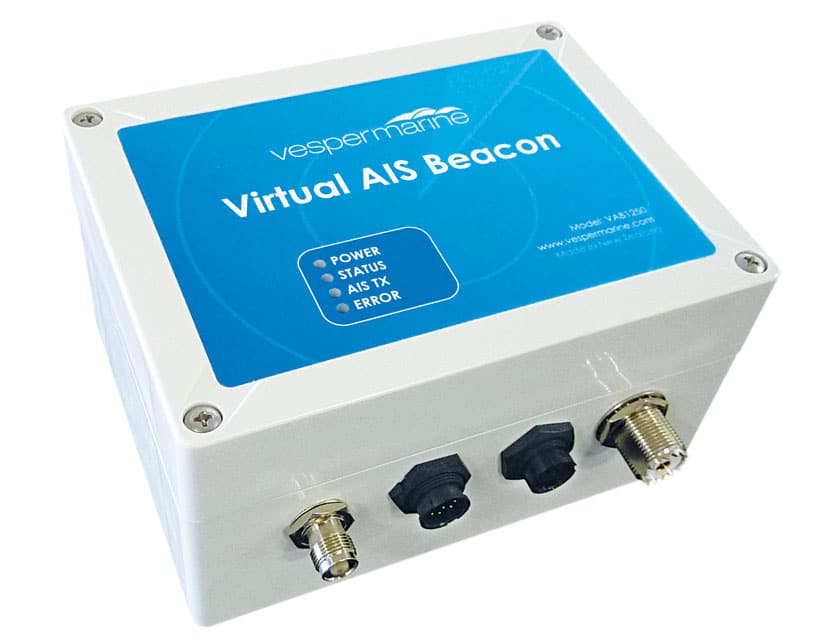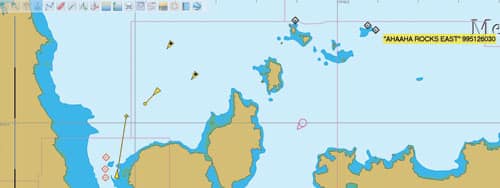
Virtual AIS Beacon
I am a dedicated runner and can’t recall the number of times that I’ve been charged by an aggressive dog, only to see Fido slam on his brakes before crossing an electronic barrier, its perimeter instantly telegraphed to his zapper collar. Vesper Marine, based in Auckland, New Zealand, specializes in Automatic Identification System (AIS) technologies and has applied the concept of an electronically demarcated zone to a system that projects an invisible fence. Instead of containing dogs, Vesper’s Virtual AIS Beacon creates dynamic virtual aids to navigation (VAtoNs) to alert a yacht’s AIS system that the yacht is approaching shoals, low-lying islands or other points of navigational concern.
VAtoNs, which can easily be deployed and remotely reconfigured to adapt to conditions, trigger AIS alarms, so that specially marked icons appear on AIS-enabled displays (including chart plotters and multifunction displays) just like real AIS targets do. But there’s typically nothing but brine in the marker’s real-world location.
Jeff Robbins, Vesper’s co-founder and CEO, said that his firm developed the Virtual AIS Beacon to help supplement existing physical aids to navigation (AtoNs), especially in areas that are otherwise impossible or extremely difficult to protect. “Physical AtoNs are really important,” Robbins said. “VAtoNs will never pass the eyeball test, but they’re a really valuable way to augment physical buoys. Nobody is talking about ripping out lighthouses or buoys and replacing them with VAtoNs, but in remote areas it’s not a matter of replacing existing infrastructure, but rather [of] putting anything in place.”
The Virtual AIS Beacon can be mounted onshore, atop a floating buoy or on an oil rig or a large ship and consists of the actual beacon, a broadcasting antenna, a means of remote communication and a power source. Depending on the station’s location, the power supply could be a direct wire run or it could be a solar panel that powers a battery bank. Also depending on location, the beacon could be hard-wired to the Internet or it could be fitted with a cellular modem, allowing it to “talk” to its administrative software, its human masters or both.
Once the unit is online, it can transmit between one and 64 VAtoNs, which can be projected up to several miles from the station. Each Virtual AIS Beacon is designed to run 24/7/365, irrespective of weather conditions, sea state, environmental concerns or varmints, yielding a system that’s capable of operating for long periods, without physical maintenance.
Vesper currently makes 2-watt and 12.5-watt models. The range for both of them — like all AIS and VHF signals — may be limited by surrounding topography, atmospheric interference or weather, but the 2-watt unit’s signal typically can be received roughly seven to 10 miles out. The 12.5-watt version roughly doubles the distance. Elevating the broadcasting antenna can dramatically increase range, but additional virtual AIS beacons ashore (for example, along a rocky and desolate lee shore) or offshore also can be linked to relay signals, thus adding nearly infinite expandability.
Unlike either Class A or Class B AIS units that frequently broadcast their position (once every two to 10 seconds for Class A and once every 30 seconds for Class B) to account for a vessel’s movement and the sea state, Vesper’s Virtual AIS Beacon can be configured to transmit at various intervals, depending on its location (e.g., surrounding terrain and whether it’s stationary or fixed), directly onto AIS frequencies (162 MHz). Both Class A and Class B units can see VAtoNs, thus ensuring that all nearby AIS-enabled traffic will “see” any newly marked underwater hazards, cordoned-off areas or repositioned shipping lanes.
The last link in this invisible fence is Vesper’s app programming interface (API), which allows an authorized human user to interact with remote virtual AIS beacons to add, remove or reposition VAtoNs via Vesper’s proprietary Windows-based software. The API presents a user with a spreadsheet-like listing of each station’s VAtoNs, their latitude/longitude and their type (users can select from a list of 32 VAtoN icons, such as Isolated Danger, Safe Water or Special Purpose), which they can edit in real time.
To date, a Virtual AIS Beacon has been used in three high-profile locations. Given Vesper’s antipodean roots, two of these spots are in New Zealand: the first on a hill above the ports of Auckland, the second on the South Island’s Doubtful Sound. The Auckland installation (established in 2012) consists of a single 12.5-watt unit that augments existing AtoNs and can (pending approval) adjust shipping lanes based on whale activity, while the Doubtful Sound beacon (a 2-watt unit) protects cruise ships and private yachts from accidentally “encountering” Tarapunga Rock. Robbins said that the Doubtful Sound location provides a perfect acid test for the technology, because localized environmental conditions are so extreme that physical AtoNs are almost immediately destroyed by storms, and the shore station’s remote location means that it can be reached only once a year via helicopter. Moreover, the station receives just a few hours of sunlight during winter months, and, Robbins said, the area is home to a bird species that eats the rubberized coating on exposed wires and seals, putting an extra demand on this crucial, remote-operated hardware. This installation has been in continuous service for several years, without problems or pecked-off wire housings.

In the display, the red diamonds in the channel are real physical aids to navigation. The black diamonds near the rocks are virtual aids.
The 2012 America’s Cup World Series races on San Francisco Bay provided a third (and vastly different) Virtual AIS Beacon installation. “We used [it] to broadcast the location of the boundaries around the racecourse to the spectator fleet,” said Stan Honey, director of technology for the 34th America’s Cup and the inventor of televised football’s “first-down” technology. “[Virtual AIS] isn’t part of the TV graphics, although it communicates the same boundary locations shown on TV.”
Virtual AIS Beacon thus presents an interesting possibility to race committees worldwide. If, for example, each competitor were required to have an AIS receiver, the race committee could reposition the windward mark, the starting line or the leeward gate to always be square to weather. While this is a great racecourse-management trick, the ability to quickly reposition virtual marks using API has far more sober-minded applications for all mariners. For example, VAtoNs can be moved to account for shifting sandbars, shipwrecks, coral reefs, charismatic megafauna or other newly “discovered” navigational hazards. Marina managers and port authorities could even theoretically set temporary VAtoNs to help guide ships and large yachts into their berths.
Invisible fences help save runners’ calves from snapping teeth, but Vesper’s Virtual AIS Beacon helps all AIS-equipped mariners avoid potentially catastrophic mishaps. Although Virtual AIS Beacon isn’t a consumer-facing product (in the United States, for example, Coast Guard approval is required for all AtoNs, virtual or otherwise), it’s a cost-effective technology that helps further the continuum of mariner safety that began centuries ago with lighthouses and now extends to virtual icons on otherwise empty-but-dangerous seascapes.
Vesper Marine, +64 9 950 4848; http://vespermarine.com









